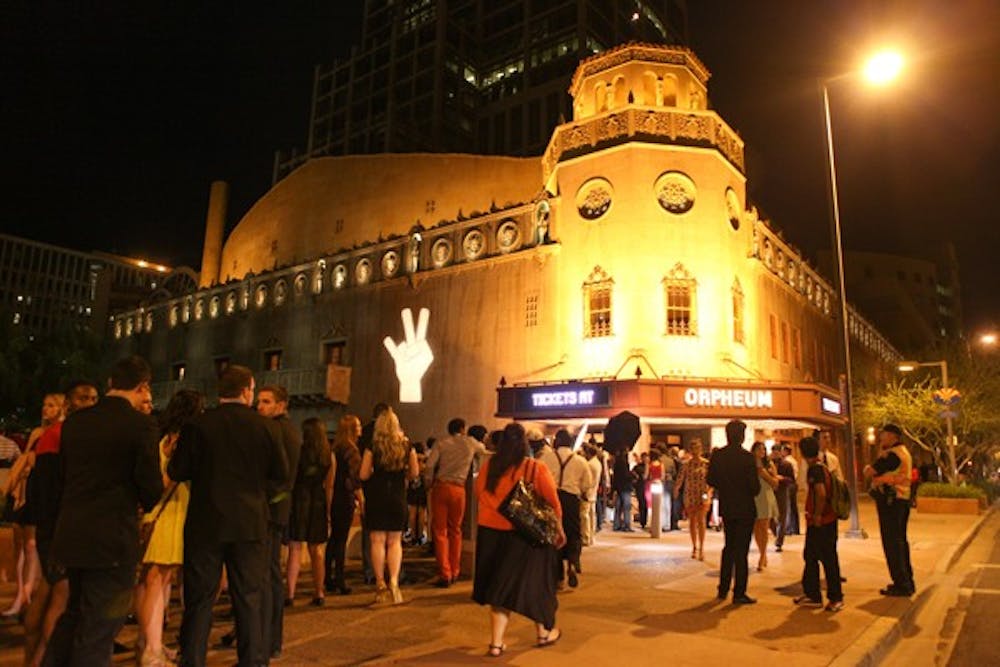 Students, faculty and guests wait in long lines to get their tickets for the Pitchfork Awards held in downtown Phoenix at the Orpheum Theatre. (Photo by Perla Farias)
Students, faculty and guests wait in long lines to get their tickets for the Pitchfork Awards held in downtown Phoenix at the Orpheum Theatre. (Photo by Perla Farias)Along with the Olympics, Gatsby, the first Academy Awards and the Charleston dance, the '20s were the groundbreaking era for Hollywood and classic Americana. From "talkies" and classic vaudeville to musicals, movies and live concert performances, the Orpheum theater has been delivering world class entertainment to Phoenix since its establishment in 1929, by two young entrepreneurs, J. E. Rickards and Harry Nace.
For more than 80 years, the Orpheum has hosted some of Hollywood’s most talented performers and highlighted shows: Carol Channing in "Hello Dolly," Judy Collins, Bette Midler, the Radio City Rockettes, and Gary Cooper and Madeline Carroll in "North West Mounted Police."
The Orpheum was created with the expressed intent of transporting moviegoers from the dreary doldrums of everyday life to the magical world of whimsy that is the theater. But while the Orpheum had remained one of Phoenix’s last old Hollywood throwbacks, by 1997 owners of the classic space were having trouble meeting the financial and architectural needs of the much-beloved Phoenix relic.
Then-mayor Terry Goddard and his newly formed "historic preservation taskforce" made a quick-close offer to purchase the theater for a paltry $1.5 million.
“We jumped at the opportunity; we pulled together the unexpected but necessary funds to save the theater,” Goddard said.
However, the conditions of the sale included a signed contract in which the mayor promised to restore the theater to its original glory, a project that launched in Jan. 28, 1997, and was just recently completed this summer.
The Orpheum Theater was entirely a “target of opportunity,” Goddard said. “It was so important for the community that we save this key piece of our Downtown history."
Undergoing this restoration proved to be both costly and time-consuming. Many financial and legal obstacles threatened to curtail the project.
One of the major hurdles was that of funding, though joint financial dedication from several donors, including CEO and chairman of MAC America Dilbert and Jewell Lewis, Junior League, MicroAge and Wells Fargo, expert architects and restores from Conrad Schmitt Studios were able to maintain the essence and integrity of the theater’s design.
Not a single detail was overlooked, from the hand-brushed application of multiple layers of color wash and gold-leafing on the pillars to the stage-framing gold ropes of the Lewis Auditorium to the exact replication of the carpet that padded the floor of the historic theater.
Wells Fargo Bank played a significant role in the styling and furnishing of the theater donating nearly every visible piece of authentic antique furniture that fills the theater, some dating back to the 19th century.
In the early 1970s, downtown Phoenix underwent significant urbanization. Many of Phoenix’s classic and most iconic buildings were lost to fire or commercial development.
However, determined to avoid a similar fate, Phoenix declared the theater a historic landmark. While the cloak of historical antiquity would protect the theater from giving way to modern construction, it also came with strict ADA restoration guidelines that limited the codes by which the theaters restoration operated. Making it hard to effectively restore certain areas such as the Historic Lobby to its original Spanish Baroque grandeur with Greek twist.
Despite all obstacles the Orpheum Theater and its many donors were able to bring back the Renaissance-like glamour and Italianate extravagance that exuded from every orifice of this atmospheric theater during its heyday in 1929. Offering its audiences a live show experience that can't be duplicated through television or movies “it was truly a treasure worth saving,” reflects Goddard.
While this theater no longer features headlining stars of old Hollywood like Charlie Chaplin, Mary Martin and Robert Preston, it's the last of the movie palaces, Goddard said. Serving as a venue for local concerts, plays, graduations and even the occasional city council meeting.
The theater is open to the public and gives occasional docent guided tours, where the public has a chance to experience the theater and learn about its fascinating journey from entertainment center to historical landmark. Tours are free, but dates and times vary, for more information about tours or upcoming event visit this link. The theater is located at 203 West Adams St., Phoenix, Arizona 85003, just across the plaza from Wells Fargo Bank.
Reach the reporter at oprichar@asu.edu or follow her on Twitter @OliviaRichard1
Like The State Press on Facebook and follow @statepress on Twitter.




